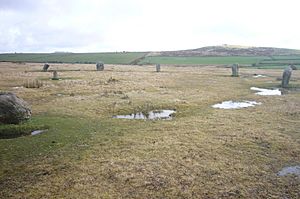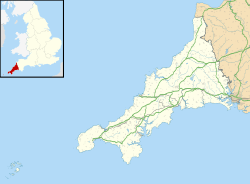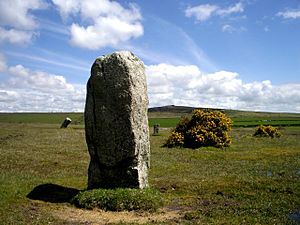Trippet stones facts for kids
 |
|
| Location | Bodmin Moor, Cornwall |
|---|---|
| Coordinates | 50°32′41″N 4°38′21″W / 50.544821°N 4.639282°W |
| Type | Stone circle |
| History | |
| Periods | Bronze Age |
The Trippet stones are an ancient stone circle found on Manor Common in Blisland, Cornwall, UK. This cool historical site is about 9 kilometers (5.6 miles) north of Bodmin on the wild and beautiful Bodmin Moor. Another stone circle, the Stripple stones, is also nearby.
Contents
What Are the Trippet Stones?
This stone circle sits on flat ground and measures about 32 meters (104.6 feet) across. It is made up of eight tall granite stones that still stand upright. Four other stones have fallen over the years.
The standing stones are usually spaced about 3.7 meters (12 feet) apart. The tallest one reaches about 1.6 meters (5.2 feet) high. The fallen stones are about 2.1 meters (6.8 feet) and 1.6 meters (5.2 feet) long.
How Many Stones Were There Originally?
Experts believe there were many more stones here long ago. One idea is that there might have been as many as twenty-six or even twenty-eight stones. Sadly, some stones were likely broken up by people over time.
The name "Trippet stones" might come from an old story. It's said the stones were once girls who were punished for "tripping lightly" (dancing) on the Sabbath, a holy day.
Connecting to Other Stone Circles
You can see the Stripple stones about 1 kilometer (0.6 miles) to the east, across some marshy land. Some historians think the Trippet stones might have been built to replace or work with the Stripple stones. They could have been part of a bigger building plan across the western part of Bodmin Moor.
Discoveries at the Site
In 1908, a researcher named H. St. George Gray looked closely at the Trippet stones. He had also dug around the nearby Stripple stones in 1905. At the Stripple stones, he found small pieces of flint and an entrance that pointed directly towards the Trippet stones. This suggests a connection between the two sites.
Ancient Star Alignments
In 1907, Norman Lockyer visited the Trippet stones. He was interested in how ancient people used stones to track the sky. He thought the circle might have been built around 1700 BC (that's about 3,700 years ago!).
He figured this out by looking at how the star Arcturus would have lined up with Rough Tor, a nearby hill. Lockyer also noticed a slight alignment between the Trippet stones and another site called the Leaze stone circle. He wondered if this alignment had something to do with how stars rose in the sky.



